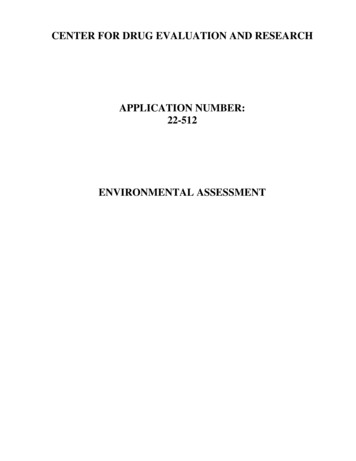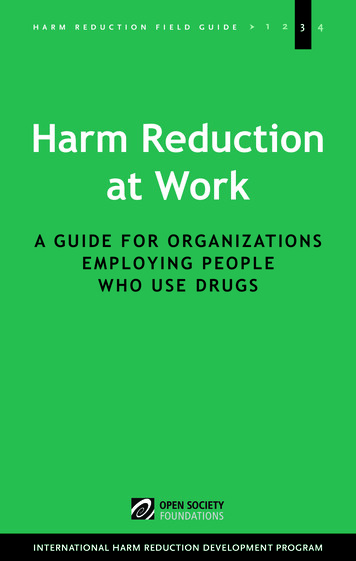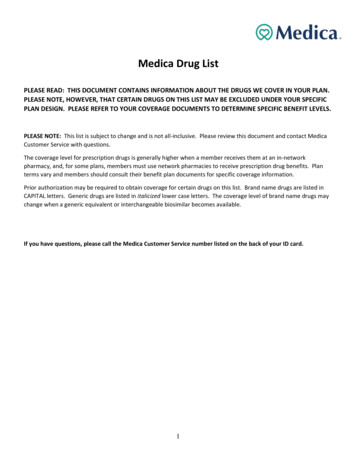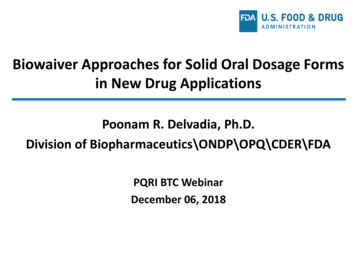
Transcription
CENTER FOR DRUG EVALUATION AND RESEARCHAPPLICATION NUMBER:22-512ENVIRONMENTAL ASSESSMENT
Environmental AssessmentFinding of No Significant ImpactNDA 22-512Dabigatran Etexilate Capsules(75 mg, 110 mg, and 150 mg)Food and Drug AdministrationCenter for Drug Evaluation and ResearchJuly 16, 2010
FINDING OF NO SIGNIFICANT IMPACTNDA 22-512Dabigatran Etexilate Capsules(75 mg, 110 mg, and 150 mg)The National Environmental Policy Act of 1969 (NEPA) requires all Federal agencies to assessthe environmental impact of their actions. The Food and Drug Administration (FDA) is requiredunder NEPA to consider the environmental impact of approving certain drug productapplications as an integral part of the regulatory process.NDA 22-512 requests approval for dabigatran etexilate capsules (75 mg, 110 mg, and 150 mg).The NDA provides for an indication for the prevention of stroke and non-CNS systemicembolism in patients with non-valvular atrial fibrillation at moderate to high risk of stroke. Insupport of its application, Boehringer Ingelheim Pharmaceuticals, Inc. prepared anenvironmental assessment (EA; attached) in accordance with 21 CFR Part 25, which evaluatesthe potential environmental impacts of dabigatran etexilate.The Food and Drug Administration, Center for Drug Evaluation and Research, has carefullyconsidered the potential environmental impact due to approval of this application and hasconcluded that this action is not expected to have a significant effect on the human environment.Therefore, an environmental impact statement will not be prepared.PREPARED BY:Raanan A Bloom, Ph.D.Senior Environmental OfficerOffice of Pharmaceutical ScienceCONCURRED BY:Nakissa Sadrieh, Ph.D.Associate Director for Research Policy and ImplementationOffice of Pharmaceutical ScienceCONCURRED BY:Moheb Nasr, Ph.D.Director, Office of New Drug Quality AssessmentOffice of Pharmaceutical ScienceAttachment: September 2009, Environmental Assessment
ENVIRONMENTAL ASSESSMENTNON-CONFIDENTIAL [FREEDOM OF INFORMATION ACT (FOIA)]SUBMISSION(Referenced Confidential Information Has Been ProvidedUnder Separate Cover)DABIGATRAN ETEXILATEDabigatran etexilate mesilate capsules(75 mg, 110 mg, and 150 mg)NDA # 22-512September 2009Boehringer Ingelheim Pharmaceuticals, Inc.900 Ridgebury RoadP.O. Box 368Ridgefield, CT 06877
Boehringer IngelheimEnvironmental Assessment (EA)ACRONYMS AND ABBREVIATIONSAFassessment factorCASchemical abstract serviceDdistribution coefficient octanol/waterD.F.dilution factorEAenvironmental assessmentEECexpected environmental concentrationEICexpected introduction concentrationFDAfood & drug administrationKddistribution coefficient for adsorptionKocorganic carbon normalised adsorption coefficientLOEClowest observed effect concentrationNOEC no observed effect concentrationOECD organisation for economic cooperation and developmentPECpredicted environmental concentrationPNECpredicted no effect concentrationPOTWpublicly owned treatment worksTADtechnical assistance documentWWTPwastewater treatment plantsPage 2 of 20
Boehringer IngelheimEnvironmental Assessment (EA)Page 3 of 20TABLE OF CONTENTSACRONYMS AND ABBREVIATIONS. 2SUMMARY:. 41. DATE:. 42. NAME OF APPLICANT/PETITIONER: . 43. ADDRESS: . 44. DESCRIPTION OF PROPOSED ACTION: . 45. IDENTIFICATION OF CHEMICAL SUBSTANCES THAT ARE SUBJECTOF THE PROPOSED ACTION:. 56. ENVIRONMENTAL ISSUES: . 77. MITIGATION MEASURES: . 118. ALTERNATIVES TO THE PROPOSED ACTION: . 119. LIST OF PREPARERS: . 1110. REFERENCES: . 1111. APPENDICES: . 1111A. CONFIDENTIAL APPENDICES:. 12APPENDIX 1: Data Summary Table . 13Confidential Appendix 1: Projected Total Usage of Dabigatran. 15Confidential Appendix 2: Basis for Expected Introduction Concentration (EIC)of Dabigatran into The External Aquatic Environment . 16Confidential Appendix 3: Basis for Predicted Environmental Concentration(PEC) of Dabigatran Into The External Aquatic Environment . 17Confidential Appendix 4: Basis for PEC/PNEC Calculation for Dabigatran . 18Confidential Appendix 5: Confidential References to Studies not primarilyconducted for the purpose of the environmental assessment . 19Confidential Appendix 6: List of Environmental Assessment Study Reports . 20
Boehringer IngelheimEnvironmental Assessment (EA)Page 4 of 20ENVIRONMENTAL ASSESSMENTDABIGATRAN ETEXILATE75 mg, 110 mg, and 150 mg capsuleSUMMARY:The Applicant certifies that the Environmental Assessment (EA) provided is in support ofDabigatran etexilate capsules. Ecotoxicity and environmental fate data are provided in thisEnvironmental Assessment to support the L(E)C50 /EIC decision criteria for the active moiety.Boehringer Ingelheim anticipates no adverse effects to humans or environmental organisms asa result of the use of Dabigatran etexilate and the excreted active moiety entering intowastewater treatment plants (WWTP) and subsequent release environments.1. DATE:September 20092. NAME OF APPLICANT/PETITIONER:Boehringer Ingelheim Pharmaceuticals, Inc.3. ADDRESS:900 Ridgebury Road, P.O. Box 368, Ridgefield, CT 068774. DESCRIPTION OF PROPOSED ACTION:a. Requested Approval: Approval of Dabigatran etexilate is requested for theprevention of stroke and non-CNS systemic embolism in patients with non-valvularatrial fibrillation at moderate to high risk of stroke. The subject EA has been submittedto support this supplement, pursuant to 21 CFR & 25.31a(a), following the Center forDrug Evaluation and Research “Guidance for Industry for the Submission of anEnvironmental Assessment”, dated July1998.
Boehringer IngelheimEnvironmental Assessment (EA)Page 5 of 20b. Need for the Action: Dabigatran etexilate is the orally active prodrug of dabigatran, anovel, synthetic, non-peptide thrombin inhibitor. Dabigatran etexilate will beadministered orally twice daily to patients with non-valvular atrial fibrillation forprevention of stroke and non-CNS systemic embolism.c. Locations of Use: Dabigatran etexilate will be used as a prescription agent, in homeand hospital environments throughout the US.d. Disposal Sites: End-user disposal at US hospitals, pharmacies or clinics of empty orpartially empty packages will follow hospital, pharmacy or clinic procedures. Empty orpartially empty containers in residences will typically be disposed of by a community’ssolid waste management system, which may include landfills, incineration and/orrecycling. Minimal quantities of unused drug may be disposed to sewer or septicsystems.5. IDENTIFICATION OF CHEMICAL SUBSTANCES THAT ARESUBJECT OF THE PROPOSED ACTION:a. Nomenclaturei. Established Name (USAN): Dabigatran etexilate mesilate(internal code: BIBR 1048 MS)ii Tradename: Dabigatran etexilate mesilateiii. Chemical Name: beta-Alanine, ]carbonyl]-N-2-pyridinyl-, ethyl ester, methanesulfateb. Chemical Abstracts Service (CAS) Registration Number:593282-20-3 (Dabigatran etexilate mesilate methane sulfonate)211915-06-9 (Dabigatran etexilate free base)c. Molecular Formula:C35H45N7O8S (Dabigatran etexilate mesilate)C34H41N7O5 (Dabigatran etexilate)d. Molecular Weight:723.86 g/mol (Dabigatran etexilate mesilate)627.75 g/mol (Dabigatran etexilate)
Boehringer IngelheimEnvironmental Assessment (EA)Page 6 of 20e. Structural Formula:CH3NNH2OH3CNNHNNOONOOOxH3CSCH3OHOActive moietya. Nomenclature:i: Established Name:Dabigatran(internal code: BIBR 953 ZW)ii: Chemical Name: beta-Alanine, nylb. Chemical Abstracts Service (CAS) Registration Number:c. Molecular Formula: C25H25N7O3d. Molecular Weight:471.51 g/mole. Structural Formula:CH3NNH2ONNHOONNHNH211914-51-1
Boehringer IngelheimEnvironmental Assessment (EA)Page 7 of 206. ENVIRONMENTAL ISSUES:Assessing Toxicity to Environmental OrganismsThe physical-chemical, fate and ecotoxicity protocols used in testing Dabigatran generallyfollowed the Technical Assistance Documents (TAD) as published in FDA’s EA TechnicalAssistance Handbook and/or Organization for Economic Co-operation and Development(OECD) standard methods. Additional information (pKa values, water solubility, hydrolysisand photolysis) was determined according to standardized in-house methods.a. ENVIRONMENTAL FATE OF RELEASED SUBSTANCESi. Identification of Substance of InterestDabigatran etexilate is the orally active prodrug of Dabigatran, a novel, synthetic, nonpeptide thrombin inhibitor. Dabigatran etexilate is devoid of any antithrombin activity.The molecular weight of the free base Dabigatran etexilate is 627.75, that of themethanesulfonic acid salt Dabigatran etexilate mesilate 723.86. After oraladministration and absorption from the gastrointestinal tract, Dabigatran etexilate isconverted by esterases into the active moiety Dabigatran (molecular weight 471.51).Dabigatran is the primary entity of interest released into the environment through use ofDabigatran etexilate. A human 14C-ADME study has demonstrated that following oraladministration, Dabigatran etexilate ( pro drug) is rapidly and almost completelyconverted to its active moiety Dabigatran. Most of the radioactivity was excreted infaeces with a small amount excreted in urine. Dabigatran was by far the dominantcompound both in faeces and in urine. The pro drug Dabigatran etexilate was notdetectable in urine and faeces. Only minor amounts of the administered dose werefound as metabolites. Due to the fact that the active moiety, Dabigatran, is by far thedominant compound excreted, the environmental risk assessment will be performed onthe basis of data on fate and effect data of Dabigatran.ii. Physical and Chemical CharacterizationDabigatran has pK values of 12.4, 4.4 and 4.1 respectively, is sparing soluble inaqueous solutions and its LogD -2.2 at the environmentally relevant pH range of 5 to9. The low LogD indicates that Dabigatran has no significant potential forbioaccumulation. Refer to Data Summary Table (Appendix 1) for review ofphysical/chemical data for Dabigatran.iii. Environmental Depletion MechanismsBased on the results of ready biodegradation studies with compounds structural similarto Dabigatran and on the structure of the substance itself, Dabigatran is considered to benot ready biodegradable. Therefore, the study on ready biodegradability was not
Boehringer IngelheimEnvironmental Assessment (EA)Page 8 of 20conducted. However, a full water/sediment study according to OECD 308 is available(see below).An adsorption coefficient of Koc 5758 (3 soils) was determined for this substanceindicating that no extensive amount of Dabigatran is expected to adsorb onto solids.Transformation in aquatic sediment systems was evaluated using OECD Method 308.Results show rapid disappearance of Dabigatran from the aerobic aquatic systems witha mean DT50 of approximately 3 days for the water compartment as well as for the totalsystem. The removal mechanism is mainly via binding to sediment (bound residues)and formation of several minor metabolites. Due to the low amounts of Dabigatrandetected in the sediment, a half life could not be calculated for this compartment. Referto Data Summary Table (Appendix 1) for review of depletion mechanism data forDabigatran.iv. Environmental Concentrations(1) Expected Introduction Concentration (EIC):EICaquatic (ppm) A X B X C X DWhere:A kg/yr produced for direct use (Confidential Appendix 1)B 1/ liters per day entering POTWs*C years/ 365 daysD 1 X 106 mg/kg (conversion factor)* 1.274 x 1011 liters per day entering POTW according to the 2006Need Survey, Report to CongressThe EIC entering into the external aquatic environment (EICaquatic) has beencalculated (Confidential Appendix 2). The calculations are based on total expectedPradaxa usage in the peak year during the first five years after introduction, and thecorresponding active moiety (Dabigatran) quantities. No adjustments have been madeto account for metabolism, other environmental depletion mechanisms, or for thedilution of wastewater effluents into the receiving waters. No seasonal patterns of useare expected.(2) Expected Environmental Concentration (EEC):The Expected Environmental Concentration (EEC), which is sometimes referred to asthe Predicted Environmental Concentration (PEC), is calculated as follows:PEC EICaquatic X [(100-R) / (100 X D.F.)]
Boehringer IngelheimEnvironmental Assessment (EA)Where:Page 9 of 20% Removal (R) 0Dilution Factor (D.F.) 10The PEC refines the original EIC estimate by accounting for Dabigatran removal onsludge during wastewater treatment and subsequent dilution into the receiving waters.As a conservative estimate, the PEC was not adjusted for Dabigatran removal bybiodegradation mechanisms or removal on sludge. A dilution factor of 10 for dilutionof wastewater effluents into the receiving waters was applied (Confidential Appendix3).v. SummaryDabigatran will enter the aquatic environment through effluents discharged bywastewater treatment plants (WWTP). Dabigatran is not volatile and therefore will notenter the air compartment. Generally, only a fraction of sludge from POTWs would beapplied to soil. Based on the Adsorption/Desorption Koc for Dabigatran, sludge appliedto land would not result in a high concentration of Dabigatran in the soil compartment.Based on these considerations, the evaluation of environmental effects was limited tothe aquatic environment.b.ENVIRONMENTAL EFFECTS OF RELEASED SUBSTANCESi. Activated Sludge Inhibition TestingDabigatran presents no significant inhibition to microorganisms and therefore is notexpected to disrupt wastewater treatment processes. Refer to Data Summary Table(Appendix 1).ii. Ecotoxicity TestingA full set of chronic data on the three aquatic species (daphnids, fish, and algae) areavailable (prepared for regulatory submission in Europe according to the EMEAguideline).No toxicity was seen in algae up to the limit of solubility. Chronic testing in daphnidsand fish resulted in NOECs of 1.0 mg/l and 3.5 mg/l respectively. Refer to the DataSummary Table (Appendix 1) for review of effects data for Dabigatran.iii. Predicted No Effect Concentration (PNEC)The PNEC is calculated by applying an assessment factor (AF) to the effects datadeveloped in the tiered testing; wherePNEC L(E)C50 or NOEC / AF
Boehringer IngelheimEnvironmental Assessment (EA)Page 10 of 20The assessment factor represents the extent of uncertainty in extrapolating test data on alimited number of species to the real environment. In general, the greater number ofspecies tested and the longer duration of tests, the smaller degree of uncertainty andsize of the assessment factor.The PNEC was based on the lowest NOEC result from the chronic base set toxicitytests. The NOEC of 1.0 mg/l from the Daphnia reproduction test was chosen as theNOEC. An assessment factor of 10 was applied to calculate the PNEC because the datais obtained from long-term toxicity tests. Therefore, the PNEC is calculated to be 0.10mg/l.The PNEC is compared to the PEC (Confidential Appendix 2). The PEC/PNEC ratio isless than one (Confidential Appendix 4) indicating that no significant risk for theaquatic environment is to be expected.iv. SummaryThe ecotoxicity of Dabigatran to three aquatic species was investigated using standardtest protocols. The PEC/PNEC ratio is less than one for the most sensitive species(Daphnia magna) indicating that no significant risk for the aquatic environment is to beexpected.c. SUMMARYBased on the PEC/PNEC risk assessment, it is unlikely that Dabigatran represents a risk to theaquatic environment. The PEC/PNEC assessment for total Dabigatran entering into theenvironment was based on a long term daphnia reproduction test as the most sensitive speciestested. The PEC calculation is also conservative as it does not take into consideration depletionvia biodegradation or photolysis. No adverse environmental effect was identified in thisassessment, as demonstrated by the calculated PEC/PNEC ratio of 1.0. The PEC/PNEC riskassessment based on total Dabigatran usage is provided in Confidential Appendix 4.Review of current data provides that “No Further Action” is required since the PEC/PNECratio of 1.0.
Boehringer IngelheimEnvironmental Assessment (EA)Page 11 of 207. MITIGATION MEASURES:No adverse environmental effects have been identified. No mitigation measures arerequired.8. ALTERNATIVES TO THE PROPOSED ACTION:No potential effects have been identified for this proposed action. No alternatives tothe proposed action are required.9. LIST OF PREPARERS:David Redalieu Associate Director, Health and Safety, Boehringer Ingelheim Pharmaceuticals,Inc. M.S. Environmental Engineering with over 20 years experience in environmental healthand safety engineering and management in the pharmaceutical industry.Wolfgang Weigl Ecotoxicologist, Boehringer Ingelheim GmbH. Dipl Geoecology withconcentrations in environmental toxicology and chemistry. Over seven years experienceconducting environmental risk assessments.The contract testing laboratories used for all studies is included in the confidentialappendices.10. REFERENCES:1. “Guidance for Industry for the Submission of an Environmental Assessment inHuman Drug Applications and Supplements”, Center for Drug Evaluation andResearch (CDER), July 1998.11. APPENDICES:1. Data Summary Table3 Pages Withhled in Full Immediately After This Page as (b)(4) CCI/TS.
ter NameProduct --------------BOEHRINGERPRADAXA (DABIGATRANINGELHEIMETEXILATE MESYLATE)PHARMACEUTICALS -------This is a representation of an electronic record that was signedelectronically and this page is the manifestation of the ----------------------------RAANAN A BLOOM07/16/2010NAKISSA SADRIEH07/16/2010MOHEB M NASR07/25/2010
Food and Drug AdministrationCenter for Drug Evaluation and ResearchOffice of Pharmaceutical Science/Immediate OfficeMemorandumDate:July 16, 2010From:Raanan A. Bloom, Ph.D.OPS/IO/SRSTo:Prafull ShiromaniOPS/ONDQAThrough: Nakissa Sadrieh, Ph.D.OPS/IO/SRSSubject:NDA 22-512, Dabigatran Etexilate Capsules (75 mg, 110 mg, and 150 mg)Review of Environmental AssessmentSponsor:Boehringer Ingelheim Pharmaceuticals, Inc.A. BackgroundBoehringer Ingelheim Pharmaceuticals, Inc., has filed an original submission pursuant to Section505 (b) of the Federal Food, Drug, and Cosmetic Act for dabigatran etexilate capsules (75 mg,110 mg, and 150 mg). The applicant has submitted an environmental assessment (EA) pursuantto 21 CFR part 25 to account for proposed usage of the active ingredient.B. DiscussionExecutive SummaryThis EA supports an original submission for the NDA supplement for dabigatran etexilatecapsules (75 mg, 110 mg, and 150 mg). Approval of dabigatran etexilate is requested for theprevention of stroke and non-CNS systemic embolism in patients with non-valvular atrialfibrillation at moderate to high risk of stroke. Dabigatran etexilate is the orally active prodrug ofdabigatran, a novel, synthetic, non-peptide thrombin inhibitor. The EA was prepared inaccordance with 21 CFR Part 25 by Boehringer Ingelheim Pharmaceuticals, Inc. The EA iscompiled in accordance with FDA ‘Guidance for Industry, Environmental Assessment of HumanDrug and Biologics Applications’ CDER, CBER, FDA July 1998.
Page 2 – NDA 22-512Dabigatran etexilate is metabolized by esterases into the active moiety dabigatran, which isexcreted. Accordingly, the environmental risk assessment was be performed on the basis of fateand effect data for dabigatran.The sponsor uses chronic ecotoxicology data to estimate toxicity parameters in the environment.Specifically, based on the chronic ecotoxicity effects data Daphnia magna is the most sensitivespecies tested. Comparison of the Expected Introductory or Maximum Expected EnvironmentalConcentration (EIC; MEEC) to this value allows the conclusion that dabigatran residues in theenvironment are not expected to present an environmental risk.C. Environmental Assessment Review1. Date: September 20092. Applicant: Boehringer Ingelheim Pharmaceuticals, Inc.3. Address:900 Ridgebury RoadP.O. Box 368Ridgefield, CT 068774. Proposed Action: Boehringer Ingelheim Pharmaceuticals, Inc., is requesting approval ofdabigatran etexilate capsules (75 mg, 110 mg, and 150 mg) for the prevention of stroke and nonCNS systemic embolism in patients with non-valvular atrial fibrillation at moderate to high riskof stroke.5. Identification of Chemicals: Dabigatran etexilate is the orally active prodrug of dabigatran,a novel, synthetic, non-peptide thrombin inhibitor.Prodrug: Dabigatran etexilatea. Nomenclaturei. Established Name (USAN): Dabigatran etexilate mesilate(internal code: BIBR 1048 MS)ii Tradename: Dabigatran etexilate mesilateiii. Chemical Name: beta-Alanine, ]carbonyl]-N-2-pyridinyl-, ethyl ester, methanesulfateb. Chemical Abstracts Service (CAS) Registration Number:593282-20-3 (Dabigatran etexilate mesilate methane sulfonate)211915-06-9 (Dabigatran etexilate free base)c. Molecular Formula:C35H45N7O8S (Dabigatran etexilate mesilate)C34H41N7O5 (Dabigatran etexilate)d. Molecular Weight:
Page 3 – NDA 22-512723.86 g/mol (Dabigatran etexilate mesilate)627.75 g/mol (Dabigatran etexilate)e. Structural Formula:Active moiety: Dabigatrana. Nomenclature:i: Established Name: Dabigatran(internal code: BIBR 953 ZW)ii: Chemical Name: beta-Alanine, 1-methyl-1H-benzimidazol-5-yl] carbonyl]-N-2-pyridinylb. Chemical Abstracts Service (CAS) Registration Number: 211914-51-1c. Molecular Formula: C25H25N7O3d. Molecular Weight: 471.51 g/mole. Structural Formula:6. Environmental CharacterizationDabigatran is sparing soluble in aqueous solutions and is not expected to bioaccumulate.The following physical and chemical properties of dabigatran are provided.The following study reports based on OECD guidelines are provided in confidential appendices:
Page 4 – NDA 22-512Widmer H. (2005): Determination of the Partition Coefficient (n-Octanol / Water) of BIBR 953(b) (4)ZW including effect of pH.Völkel W. (2006): Determination Adsorption/Desorption of [14C]- BIBR 953 ZW on Soils.Physical/Chemical PropertiesEnvironmental Depletion MechanismsAccording to the applicant, dabigatran is considered not to be ready biodegradable based onresults with similar compounds. A ready biodegradability study was not conducted. Awater/sediment study conducted according to OECD 308 provides some information ondegradation and is provided in a confidential appendix.Mamouni A. (2006): 14C-BIBR 953 ZW: Route and Rate of Degradation in Aerobic Aquatic(b) (4)Sediment Systems.(b) (4)
Page 5 – NDA 22-512(b) (4)Environmental ConcentrationsThe sponsor estimates a projected total usage of dabigatran etexilate mesilate at market peak(b) (4)(b) (4)(2015) ofkg/yr. This results in an EIC of(ppb) according to the EIC equation(EA Guidance Document) using a POTW effluent value of 1.274 X 1011 liters per day (2006EPA Need Survey).
Page 6 – NDA 22-512A human 14C-ADME study has demonstrated that following oral administration dabigatranetexilate is converted by esterases into the active moiety dabigatran. Based on a stoichiometricratio of dabigatran etexilate mesilate to dabigatran of 0.651; the projected total usage of(b) (4)(b) (4)dabigatran at market peak iskg/yr. This results in an EIC ofThe expected environmental concentration (EEC) is derived from the EIC by applying a default(b)factor of (4) for dilution in surface waters; EEC 0.088 ug/LEnvironmental Fate and EffectsEnvironmental FateDabigatran will be excreted and enter the aquatic environment after patient use and disposalthrough effluents discharged by wastewater treatment plants. Dabigatran is not volatile and is notexpected to enter the atmosphere. The low Pow ( -2.2) indicates a low tendency to(b) (4)bioaccumulate. Koc values ofindicate some irreversible binding in sediments may occurresulting in bound residues. Additional metabolites may also be formed. The majority ofresidues are expected to enter the aquatic compartment.Ecological ToxicityThe following studies conducted according to OECD guidelines are provided in confidentialappendices:Peither A. (2006): BIBR 953 ZW: Toxicity to Scenedesmus subspicatus in a 72-hour algal(b) (4)growth inhibition test.Peither A. (2006): BIBR 953 ZW: Effect on survival and reproduction of Daphnia magna in a(b) (4)semi-static test over three weeks.Peither A. (2006): BIBR 953 ZW: Toxic effects to zebra fish (Brachydanio rerio)in an early-life(b) (4)stage toxicity test.U06-0212 Peither A. (2006): BIBR 953 ZW: Toxicity to activated sludge in a respiration(b) (4)inhibition test.
Page 7 – NDA 22-512SummaryThe sponsor uses chronic ecotoxicology data to estimate toxicity parameters in the environment.Specifically, based on chronic ecotoxicity effects data, Daphnia magna are considered the mostsensitive species tested. The PNEC is based on a NOEC value of 1.0 mg/L. Comparison of theExpected Introductory or Maximum Expected Environmental Concentration (EIC; MEEC) to(b) (4)this value results in a ratio significantly greater than 10 (NOEC/EIC ), allowing theconclusion that dabigatran residues in the environment are not expected to present anenvironmental risk.Cumulative Environmental Fate and EffectsDabigatran is an original submission. There are no U.S. marketed generic applications or otherNDA applications and dabigatran is not listed in the IMS National Sales data set. Dabigatranetexilate is marketed as Pradaxa in European countries since April 2008 and Pradax in Canada.7. Mitigation Measures and AlternativesSince no adverse environmental impact is expected, no mitigation methods are addressed.D. Literature ReviewedNo literature on dabigatran as related to environmental occurrences, fate and ecotoxicity werefound.E. Comments and ConclusionsComparison of the EIC to NOEC values allows for the conclusion that dabigatran residues in theenvironment are not expected to present an environmental risk.
Page 8 – NDA 22-512Based on an evaluation of the information provided in this EA and previous EAs, in FDAguidance, and on the scientific validity of the “no effects” conclusions of the EA, no significantadverse environmental impacts are expected from the approval of this NDA.A Finding of No Significant Impact (FONSI) is recommended.
ter NameProduct --------------BOEHRINGERPRADAXA (DABIGATRANINGELHEIMETEXILATE MESYLATE)PHARMACEUTICALS -------This is a representation of an electronic record that was signedelectronically and this page is the manifestation of the ----------------------------RAANAN A BLOOM07/16/2010NAKISSA SADRIEH07/16/2010
the basis of data on fate and effect data of Dabigatran. ii. Physical and Chemical Characterization Dabigatran has pK values of 12.4, 4.4 and 4.1 respectively, is sparing soluble in aqueous solutions and its Log D -2.2 at the environmentally relevant pH range of 5 to 9. The low Log D indicates that Dabigatran has no significant potential for











